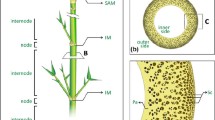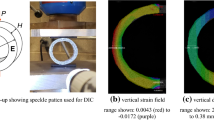Abstract
In order to enhance the understanding of the microstructural characteristics of bamboo culm within transverse directions, two micromechanics models, Halpin–Tsai (H–T) equations and Mori–Tanaka (M–T) model, are introduced to generate the homogenized moduli in the transverse direction, which cannot be easily predicted using the traditional rule of mixtures that was mostly adopted in the previous literatures. A multi-scale framework is then created by connecting the micromechanics models with structural analysis of bamboo culm cross section, which is treated as concentric composite cylinders composed of fiber vascular bundles and ground tissue with different volume fractions that usually increase from inner periphery to outer periphery. Finally, several numerical examples are illustrated to prove the availability of the present micromechanics models in calculating homogenized moduli and practicing bamboo structural analysis. It has been found that the H–T equations and M–T model usually predict well-matched homogenized moduli, leading to similar stress distributions along the radial direction under symmetric loading boundary conditions. In general, both micromechanics models provide easy predictions of homogenized moduli for future numerical and experimental research of bamboo cross sections.










Similar content being viewed by others
References
Nogata F, Takahashi H (1995) Intelligent functionally graded material: bamboo. Compos Eng 5(7):743–751
Amada S, Untao S (2001) Fracture properties of bamboo. Compos B Eng 32:451–459
Food and agriculture organization of the United Nations (2010) Global forest resource assessment 2010. Good and agriculture organization of the United Nations, Rome
Grosser D, Liese W (1971) On the anatomy of Asian bamboos, with special reference to their vascular bundles. Wood Sci Technol 5:290–312
Dixon PG, Gibson LJ (2014) The structure and mechanics of moso bamboo material. J R Soc Interface 11(99):20140321
Shao Z-P, Fang C-H, Huang S-X, Tian G-L (2010) Tensile properties of moso bamboo (phyllostachys pubescens) and its components with respect to its fiber-reinforced composite structure. Wood Sci Technol 44:655–666
Li H, Shen S (2011) The mechanical properties of bamboo and vascular bundles. J Mater Res 26(2):2749–2756
Tan T, Rahbar N, Allameh SM et al (2011) Mechanical properties of functionally graded hierarchical bamboo structures. Acta Biomater 7:3796–3803
Garcia JJ, Rangel C, Ghavami K (2012) Experiments with rings to determine the anisotropic elastic constants of bamboo. Constr Build Mater 32:52–57
Sharma B, Harries KA, Ghavami K (2013) Methods of determining transverse mechanical properties of full-culm bamboo. Constr Build Mater 38:627–637
Shang L, Sun Z, Liu X, Jiang Z (2015) A novel method for measuring mechanical properties of vascular bundles in moso bamboo. J Wood Sci 61:562–568
Amada S, Lakes RS (1997) Viscoelastic properties of bamboo. J Mater Sci 32:2693–2697. doi:10.1023/A:1018683308211
Amada S, Munekata T, Nagase Y et al (1996) The mechanical structures of bamboos in viewpoint of functionally gradient and composite materials. J Compos Mater 30(7):800–819
Lee PH, Odlin M, Yin H (2014) Development of a hollow cylinder test for the elastic modulus distribution and the ultimate strength of bamboo. Constr Build Mater 51:235–243
Wang YZ, Zhang CL, Chen WQ (2015) An analytical model to predict material gradient and anisotropy in bamboo. Acta Mech. doi:10.1007/s00707-015-1514-0
Zhou A, Huang D, Li H, Su Y (2012) Hybrid approach to determine the mechanical parameters of fibers and matrixes of bamboo. Constr Build Mater 35:191–196
Silva ECN, Walters MC, Paulino GH (2006) Modeling bamboo as a functionally graded material: lessons for the analysis of affordable materials. J Mater Sci 41:6991–7004. doi:10.1007/s10853-006-0232-3
Askarinejad S, Kotowski P, Shalchy F, Rahbar N (2015) Effects of humidity on shear behavior of bamboo. Theor Appl Mech Lett 5:236–243
Youssefian S, Rahbar N (2015) Molecular origin of strength and stiffness in bamboo fibrils. Sci Rep. doi:10.1038/srep11116
Sato M, Inoue A, Shima H (2017) Bamboo-inspired optimal design for functionally graded hollow cylinders. PLoS ONE. doi:10.1371/journal.pone.0175029
Ray AK, Das SK, Mondal S (2004) Microstructural characterization of bamboo. J Mater Sci 39:1055–1060. doi:10.1023/B:JMSC.0000012943.27090.8f
Ray AK, Mondal S, Das SK, Ramachandrarao P (2005) Bamboo—a functionally graded composite—correlation between microstructure and mechanical strength. J Mater Sci 40:5249–5253. doi:10.1007/s10853-005-4419-9
Page DH, El-Hosseiny F, Winkler K, Lancaster APS (1977) Elastic modulus of single wood pulp fibers. Tappi 60:114–117
Cichocki FR Jr, Thomason JL (2002) Thermoelastic anisotropy of a natural fiber. Compos Sci Technol 62(5):669–678
Madsen B, Hoffmeyer P, Thomsen AB, Lihholt H (2007) Hemp yarn reinforced composites—I. Yarn characteristics. Compos A 38:2194–2203
Madsen B, Hoffmeyer P, Lihholt H (2007) Hemp yarn reinforced composites—II. Tensile properties. Compos A 38:2204–2215
Drago AS, Pindera M-J (2007) Micro-macromechanical analysis of heterogeneous materials: macroscopically homogeneous vs periodic microstructures. Compos Sci Technol 67:1243–1263
Hill R (1965) A self-consistent mechanics of composite materials. J Mech Phys Solids 13(4):213–222
Halpin JC, Kardos JL (1976) The Halpin–Tsai equations: a review. Polym Eng Sci 16(5):344–352
Adams DF, Doner DR (1967) Transverse normal loading of a unidirectional composite. J Compos Mater 1:152–164
Hewitt RL, de Malherbe MC (1970) An approximation for the longitudinal shear modulus of continuous fibre composites. J Compos Mater 4(2):280–282
Mori T, Tanaka K (1973) Average stress in the matrix and average elastic energy of materials with misfitting inclusions. Acta Metall 21:571–574
Benveniste Y (1987) A new approach to the application of Mori–Tanaka’s theory in composite materials. Mech Mater 6:147–157
Eshelby JD (1957) The determination of the elastic field of an ellipsoidal inclusion, and related problems. Proc R Soc A 241:376–396
Pindera M-J, Khatam H, Drago AS, Bansal Y (2009) Micromechanics of spatially uniform heterogeneous media: a critical review and emerging approaches. Compos B 40:349–378
Wang G (2016) Generalized locally exact homogenization theory for unidirectionally reinforced composites. Ph.D. dissertation, University of Virginia
Jones RM (1999) Mechanics of composite materials, 2nd edn. Taylor and Francis, New York
Wang G, Pindera M-J (2017) Tailoring the moduli of composites using hollow reinforcement. Compos Struct 160:838–853
Wang G, Pindera M-J (2017) Elasticity-based microstructural optimization: an integrated multiscale framework. Mater Des 132:337–348
Kennedy J, Eberhart R (1995) Particle swarm optimization. In Proceedings IEEE international conference on neural networks, pp 1942–1948
Acknowledgements
The authors acknowledge the generous permission Prof. Dongsheng Huang at Nanjing Forestry University for providing source of Fig. 2 to illustrate the RVE of bamboo culm cross section. The corresponding author has also benefited from the communications with Professors W. Q. Chen and C. L. Zhang of Zhejiang University.
Author information
Authors and Affiliations
Corresponding author
Rights and permissions
About this article
Cite this article
Zhao, X., Wang, G. & Wang, Y. Micromechanical modeling in determining the transverse elastic moduli and stress distributions of bamboo. J Mater Sci 53, 2553–2565 (2018). https://doi.org/10.1007/s10853-017-1692-3
Received:
Accepted:
Published:
Issue Date:
DOI: https://doi.org/10.1007/s10853-017-1692-3




